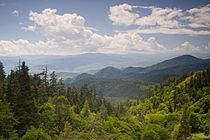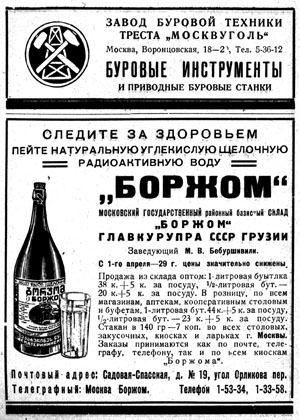Borjomi (water) facts for kids

English Version Logo
|
|

Glass bottle with Georgian label
|
|
| Country | Georgia |
|---|---|
| Produced by | IDS Borjomi |
| Introduced | 1890 |
| Calcium (Ca) | 20–150 mg/dm3 |
| Chloride (Cl) | 250–500 mg/dm3 |
| Bicarbonate (HCO3) | 3500–5000 mg/dm3 |
| Magnesium (Mg) | 20–150 mg/dm3 |
| Potassium (K) | 15–45 mg/dm3 |
| Sodium (Na) | 1000–2000 mg/dm3 |
| TDS | 5000–7500 mg/dm3 |
| All concentrations in milligrams per liter (mg/L); pH without units | |
Borjomi (Georgian: ბორჯომი) is a well-known brand of naturally sparkling mineral water. It comes from special springs in the Borjomi Gorge in central Georgia. The water in these springs comes from glaciers high up in the Bakuriani mountains. It filters through rocks and rises to the surface all by itself, without needing pumps. This natural water is then sent through pipes to two bottling factories in the town of Borjomi.
People in the Borjomi Gorge knew about these mineral springs for over a thousand years. But they became widely famous in the early 1800s. This happened after the Russian Imperial Army soldiers, who were stationed there, noticed the water helped them feel better. By the 1890s, Borjomi was popular across the Russian Empire. Even the Russian royal family, the Romanovs, liked it. It was bottled on the Georgian lands owned by Grand Duke Mikhail of Russia.
After the Russian Revolution of 1917 and when the Soviet Union took over Georgia, the Borjomi company became owned by the government. The water then became a top product exported by the Soviet Union.
Today, Borjomi is made by IDS Borjomi Georgia. This company is part of a bigger international group called IDS Borjomi International. In June 2022, the company that controlled IDS Borjomi International gave some of its shares to the Government of Georgia. This was done to follow international rules. Because of this, a representative from the Georgian government became the Chairman of the Board of Directors for IDS Borjomi International.
In 2005, about 200 million bottles of Borjomi were produced. In 2007, Borjomi received an international certificate for safety and quality called ISO 22000. This was given by Bureau Veritas, a company that checks quality. Now, Borjomi is sold in 40 countries around the world.
Georgian and Russian scientists have suggested that Borjomi water can help with some digestive diseases and diabetes mellitus.
Contents
The Story of Borjomi Water
The mineral springs in the Borjomi Gorge were found more than a thousand years ago. Archeologists found seven large stone tubs from the early 7th century. These show that people used the spring water, probably for bathing. The springs were not used for a long time until they were found again in the early 1800s. At that time, because of many wars, Borjomi and the areas around it had very few people and were covered in thick forests.
How Borjomi Was Rediscovered
In 1829, the Imperial Russian Army was in Borjomi for battles against the Ottoman Empire. Russian soldiers found mineral springs on the right side of the Borjomi river. Colonel Pavel Popov, their commander, was curious. He ordered the springs to be cleaned and the water to be bottled. He wanted it sent to the army base. Colonel Popov had stomach problems and tried the water first. When he felt better, he had stone walls built around the spring. He also had a bath house and a small house built nearby for himself.
In 1837, a new army group, the Georgian grenadiers, arrived. Their doctor, Amirov, studied the water and its effects. He sent the first results of his analysis to Saint Petersburg and Moscow. By 1841, Borjomi water was so famous for its healing effects that the Russian Tsar's representative in the Caucasus, Yevgeni Golovin, brought his sick daughter to the springs for treatment. She got better quickly. So, he named the first spring Yekaterinsky after his daughter Yekaterina. He named the second spring Yevgeniyevsky after himself.
Borjomi Becomes a Famous Spa
Golovin also helped to officially transfer the springs from the military to civilian control. In 1850, a mineral water park opened in Borjomi. In 1854, the government ordered the building of the first bottling factory. Borjomi water became popular across the Russian Empire for its healing powers. The government started building palaces, parks, gardens, and hotels for visitors and patients.
Traveling from Tiflis (now Tbilisi) to Borjomi used to take 8–9 hours by horse-drawn carriages. However, a new railroad built in 1894 between Mikhaylovo and Borjomi made the trip much shorter. Famous people like Anton Chekhov and Pyotr Ilyich Tchaikovsky visited the springs, as did members of the Russian royal family. At that time, Borjomi was as popular as other European spas like Vichy. This earned Borjomi the nickname "the Russian Vichy" and "the pearl of the Caucasus."
In 1894, Grand Duke Mikhail Romanov built a bottling factory in the Borjomi park. This factory continued to operate until the 1950s. A glass factory was built in 1896. The money earned from the Borjomi water business made Mikhail's son, Nikolay, very rich. By 1914, he was the wealthiest of all Russian grand dukes. In 1854, 1,350 bottles of water were produced. By 1905, this number reached 320,000, and by 1913, over 9 million bottles were sold.
After the Soviet Union took control of Georgia, Borjomi was sold widely across the Soviet Union. Soviet leaders like Joseph Stalin especially liked it. From 1927 to 1982, many wells were drilled in the Borjomi Gorge to find more water. In 1961, 423,000 bottles of Borjomi were sent to 15 countries, including the United States, France, and Austria. During the time of the Soviet Union, Borjomi was known as one of the top three brands, along with the Volga car and Aeroflot airlines. In the 1980s, about 400 million bottles of Borjomi water were produced each year.
Borjomi in Recent Times
Production slowed down when the Soviet Union ended and Georgia became an independent country. In 1995, the Georgian Glass and Mineral Waters Company (GG&MW) started bottling Borjomi again. They increased production by 40 times. The company said that 80% of the Borjomi made that year was sent to other countries, with more than half going to Russia. Even though fake Borjomi drinks were made by pirates in the 1990s, Borjomi water became popular again by 2000 with new packaging. The problem with fake drinks also slowed down after the 1998 Russian financial crisis.
In May 2006, Russia stopped importing Georgian mineral waters, saying they were not safe. This ban was lifted after seven years in 2013. Georgia saw this as an attempt to limit their access to the Russian market. They felt Borjomi was being used in political games. Because of the ban, GG&MW lost a lot of money in 2006. However, the company announced by 2008 that they had overcome the problem, and sales were back to normal. Sales and exports of Borjomi water dropped again by 30-40% starting in October 2008 because of the Great Recession. But by 2010, the company said that Borjomi sales were the same as before the ban. In 2011, the company sold 15% more Borjomi than they did before the ban. Today, Borjomi is sold in 40 countries worldwide. In countries that were once part of the Soviet Union, Borjomi is the most popular imported mineral water brand.
Borjomi is currently produced by IDS Borjomi Georgia, which is part of the international company IDS Borjomi International. This company is registered in Curaçao. As of June 13, 2022, the company that controlled IDS BORJOMI International gave 7.73% of its shares to the Government of Georgia for free. Because of this, a representative from the Government of Georgia became the Chairman of the Board of Directors for IDS BORJOMI International.
Today, the company makes three products in the Borjom-Bakuriani valley:
- Borjomi
- Likani
- Bakuriani
How Borjomi Water is Unique
Borjomi is a special water that comes from volcanoes. It is over 1,500 years old. Natural carbon dioxide gas pushes it up to the surface from 1500 meters (about 4,900 feet) underground. Borjomi does not get cold before it reaches the surface. It comes out at a warm temperature of 38 to 41 degrees Celsius (100 to 106 degrees Fahrenheit). The Borjomi springs are located in the middle of the Adjara-Imereti mountain range of the Greater Caucasus. They are about 760 to 920 meters (2,500 to 3,000 feet) above sea level. Each of the nine spring wells is about 1,200 to 1,500 meters (3,900 to 4,900 feet) deep.
To make sure the mineral makeup of the springs stays the same, the Georgian Ministry of Environment Protection and Natural Resources approved a plan in 2006. This plan allows for bottling over 1 million bottles a day using 10 wells in the Borjomi Gorge. The wells are in three main areas: Central (near Borjomi town), Likani (in Likani village), and Vashlovani-Kvibisi (in Vashlovani and Kvibisi villages). The water from these wells travels through a 25-kilometer (15.5-mile) stainless steel pipeline to two bottling factories. There, it is cooled and put into bottles. One factory puts the water into glass bottles, and the other puts it into PET plastic bottles.
Making mineral water and the tourism it brings to Borjomi and the nearby Borjomi-Kharagauli National Park make up 10 percent of Georgia's export trade.
How Borjomi is Packaged
Borjomi comes in glass bottles of 0.33 and 0.5 liters. It also comes in plastic bottles of 0.5, 0.75, 1, and 1.25 liters. You can also find it in 0.33-liter aluminum cans. Both glass and PET plastic bottles have screw caps. The special greenish color of the glass bottles is called Georgian Green. It is made with a secret formula. Like other single-use plastic items, used water bottles are a big part of Georgia's plastic pollution problem.
In February 2011, Borjomi water got new packaging with a "modern look." This new design highlighted the deer image and the manufacturer's sign on the label. At the end of 2019, Borjomi changed its design again. The new bottles are simpler and more modern. They say "Georgian mineral water" and have silver stripes.
Awards Borjomi Has Won
- 1907 SPA Grand Prix
- 1909 Kazan Grand Golden Medal
- 1911 Dresden Diploma of Honour
- 1940 Tallinn Golden Medal
- 1975 Budapest Diploma of Honour, World Exhibition
- 1998 Novosibirsk Golden Medal
- 1996, 1997, 1998 St. Petersburg Golden Medal
See also
 In Spanish: Borjomi (agua) para niños
In Spanish: Borjomi (agua) para niños





